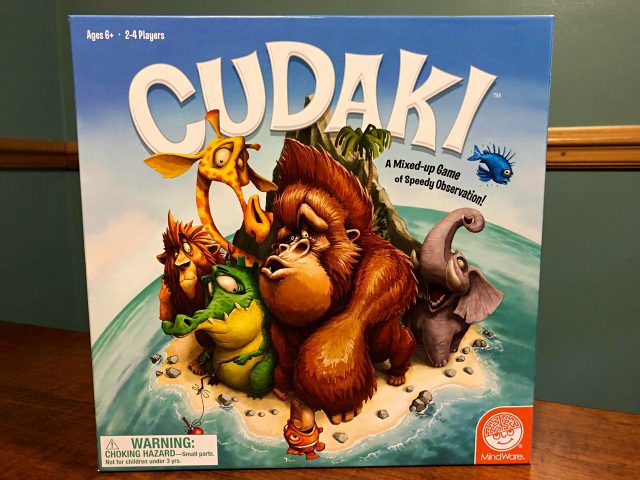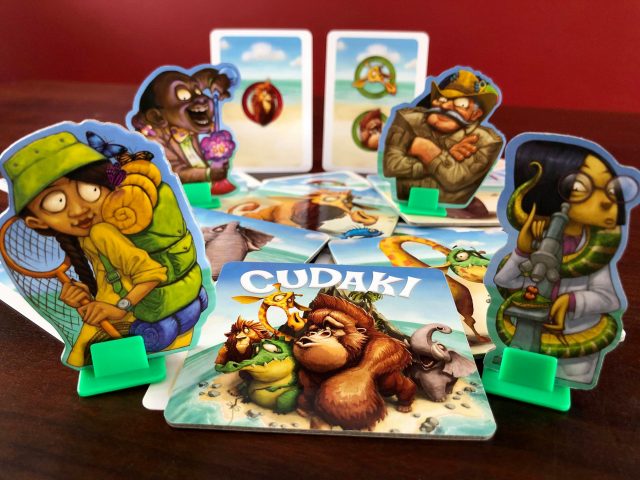As a parent obsessed with board games, the most wondrous experience is not walking or talking or toilet training… Wait – actually, yes, it’s toilet training. My days of experiencing avant garde poop art are numbered – so close I can smell it!
Where was I? Oh yes, holy grail experience. My eldest daughter (closing in on 4 years old, far too quickly for my liking!) has recently shown an interest in board games, and it is the most wondrous unlocked achievement that does not involve dirty diapers! She has started asking about games left out the morning after a game night, identifying stray game pieces under the couch, and finding games of her own to play.
The Big Bean often joins me for trips to our local game cafe (The Board Room Game Cafe in Halifax, Nova Scotia), but our best browsing experiences often happen at Scholar’s Choice, a well-established Canadian retailer and distributor of educational toys and games. During a recent visit, the artwork of Cudaki caught her eye – colourful animals with worried looks on their puzzled faces, crammed onto a tiny island, suggesting that an interesting story might be hiding within its box!

Originally published as Galapa Go in 2011, Cudaki is a game of quick reactions for 2 to 4 players, takes about 20 minutes to play, and is recommended for ages 6 and up. Players are dropped into a strange land populated by bizarre creatures – a gorilla with an alligator head, an elephant with a lion’s face, and a healthy helping of other crazy combinations. Hunters are combing this land to capture these beasts, and we all need to act fast to save them!
Fifteen animal tiles (of the 30 included) are laid out on the table at the beginning of the game, and each turn involves flipping over a card with information about which animals might targeted. Cards feature green and/or red icons, indicating which animals must (or must not) be visible on a tile. Once a card is flipped, players quickly act to place their pawn on a tile that matches the card criteria. Pawns may not be moved once placed, and once all players have placed a pawn (or chosen not to), cards a collected into a score pile for each individual. If a player dropped their explorer on an incorrect tile, they take nothing, and discard one of their previously claimed tiles.

Once there are fewer than two animal tiles on the table, the final 15 tiles are spread out on the table, and the second round of the game begins in the same way. At the end of the game, players count up their claimed tiles, and whoever has gathered the most is declared the winner!
In order to introduce this game to my 3-year-old, we started with criteria cards that only included a single instruction, and every few turns we added an extra element, until pretty much every card in the game was being used. When a card was flipped, I briefly said aloud what it was asking us to find, and Big Bean was very quick to claim a correct tile most of the time. We did not include the punishment of losing a claimed tile if a pawn was incorrectly placed, which kept the game moving without too many negative experiences. By the time we played the game a second time, I rarely needed to explain a card, and my smaller foe was quickly outplaying me in her lightning-fast reactions!

We both thoroughly enjoyed the game, and she has asked to play it nearly every day since it was introduced. The artwork inspires giggles and commands attention, even amidst the other colourful toys in our play space, which is a great credit to the graphic design. The tiles are thick, and the cards sturdy and durable, which are very important considerations when picking games for small hands! Allowing for quick moments of deduction and pattern recognition, the game is great for building some critical skills in young people, and if introduced with staggered complexity, can avoid being overwhelming to younger players. Given its similarity to games like Spot It, Jungle Speed, and other popular titles, I suspect this game will find a permanent space in our collection, as it can easily be enjoyed as part of a game night with adults, in addition to being an options for the little ones!
One curiosity is that other editions of this game include components for up to 6 players, while the English-only Mindware version only plays up to 4. It will be an easy task to add extra pawns for more players, but a seemingly odd choice.
All things considered, Cudaki is a winner for our chaotic clan! We look forward to bringing it back to the table soon, and eventually introducing it to our younger daughter.
So great! Always looking for kid-friendly games! Keep them coming!
We definitely look forward to hearing how JP turns his kids into little gamers!